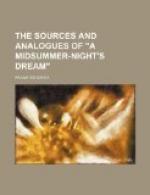A Midsummer-Night’s Dream, like too many other plays of Shakespeare, has been unable to escape the inquisition of “deuteroscopists”—those who are always on the look-out for historical and other allusions. The dainty passage (II. i. 148-174), in which Oberon gives Puck directions how and where to find the magic herb that works the transformations of love in the rest of the play, appears to contain a reference to Elizabeth as “a fair vestal throned by the west” and “the imperial votaress.” So much may be reasonably granted; but Warburton in his edition proceeded to identify “the mermaid on a dolphin’s back” with Mary Queen of Scots, the dolphin of course being the Dauphin, and so forth. This interpretation of the alleged secret allegory was displaced in 1843 by one rather more plausible—though still needlessly fantastic.
Oberon’s Vision, by the Rev. N.J. Halpin (Shakespeare Society, 1843) attempts to prove that in composing this passage Shakespeare was referring to the Earl of Leicester’s attempt to win Elizabeth’s hand, when she visited him at Kenilworth in 1575; the mermaid, uttering dulcet and harmonious breath, so that the rude sea grows civil, and the stars that shot from their spheres, are explained, by parallel passages from contemporary accounts, as parts of the pageant or “Princely Pleasures” which formed the Queen’s entertainment. The Earl was simultaneously intriguing with Lettice, Countess of Essex, who ultimately became his wife; and it is she who, according to the Rev. Halpin, is intended by the “little western flower”; to him the passage means:—
“Cupid, on behalf of
the Earl of Leicester, loosed an arrow at Queen
Elizabeth; but the Virgin
Queen’s maidenhood was so unassailable that
the bolt missed her, hitting
the Countess of Essex, who succumbed.”
In other words, Shakespeare mentions the Queen only in order to point out her rival’s success!
It is as unnecessary to discuss the degrees of probability in Halpin’s identifications as it was for him to elaborate them. Certainly it is likely that Shakespeare intended a compliment to his queen; it is possible that the “mermaid on a dolphin’s back” was a reminiscence of a pageant which he might have visited Kenilworth at the age of eleven to see; and it may be true that he meant to hint at Leicester.
On the other hand, I think that another explanation is more obvious and more rational. Shakespeare had to introduce into his play the magic herb which was to alter the loves of those into whose eyes it was squeezed. We may reasonably guess that he had read somewhere one of the many popular legends that explain why the violet is purple, why the rose is red, etc.; there are some in Ovid’s Metamorphoses[93] which Shakespeare read in Golding’s translation. He saw an opportunity of paying a graceful compliment to Elizabeth by saying that the magic flower, once white, had been empurpled by a shaft of Cupid’s drawn at the fair vestal and imperial votaress, who yet passed on untouched;




